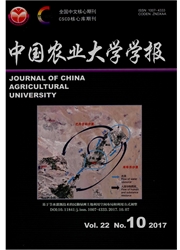

 中文摘要:
中文摘要:
利用中国农业大学选育的高油型孤雌生殖单倍体诱导系(CAUHOI)对提高玉米单倍体诱导率和加倍率的方法进行了研究。单倍体诱导试验表明,花丝长短和授粉时间对单倍体诱导率有重要影响:延迟授粉(长花丝≥8cm)的平均单倍体诱导率为3.86%.约为正常授粉(短花丝≤5cm)条件下的1.5倍;伏后授粉的诱导率平均为4.70%,约为伏期授粉的2倍。证明延迟授粉时间和较低的温度有利于提高单倍体诱导率。秋水仙素加倍试验表明,浸根法和注射法对植株伤害较严重,存活率低于50%;浸种法(0.6mg/mL)和注射法(0.4mg/mL)的散粉率较高(48.35%,28.09%),相应的结实率也较高(14.29%.10.1196),说明浸种法处理效果最好,注射法次之。
 英文摘要:
英文摘要:
A high oil haploid inducer named CAUHOI released by China Agricultural University was used in the study of haploid inducing and doubling. Results indicated that the haploid inducing rate was significantly influenced by the silk length and pollination date. The haploid inducing rate of longer silk (≥8 cm ) pollination was 3.86% on average, almost 1.5 times higher than that of shorter silk (≤5 cm) pollination; haploid .inducing rate of late summer pollination was 4.70% on average, almost two times higher than that of mid summer pollination. These results showed that late pollination and low temperature would increase haploid inducing frequency. Of the four haploid colchicine doubling treatments (immersing shoots, seedling roots, seeds and microinjecting growing point), the plant survival rates of immersing seedling roots and microinjecting growing point were lower than 50%. Doubling frequencies of immersing seed at 0.6 mg/mL concentration and microinjecting growing point at 0.4 mg/mL concentration performed better, with the rate of fertile plants at 48% and 28% and the seed rate of plants at 14% and 10% respectively. These results showed that immersing seed and microinjecting growing point would be better options for chromosome doubling.
 同期刊论文项目
同期刊论文项目
 同项目期刊论文
同项目期刊论文
 期刊信息
期刊信息
